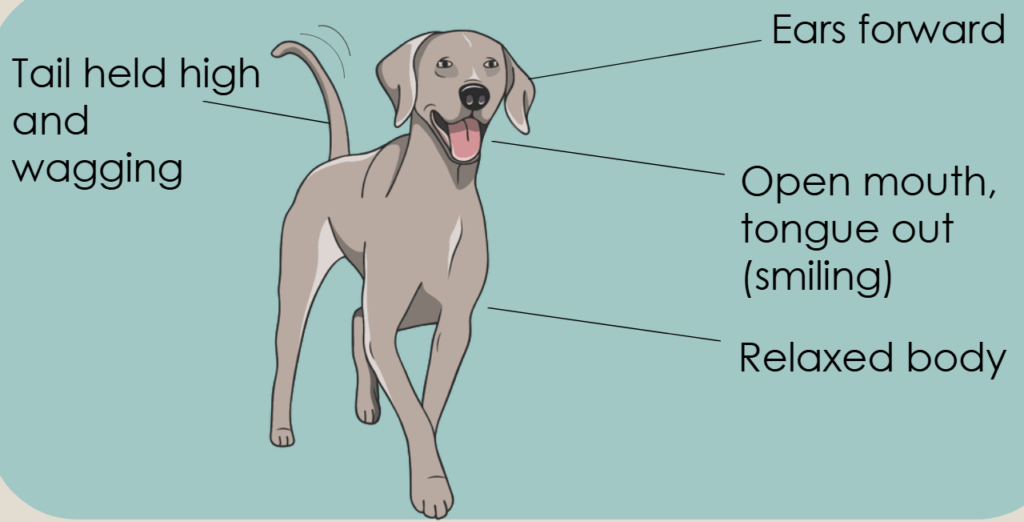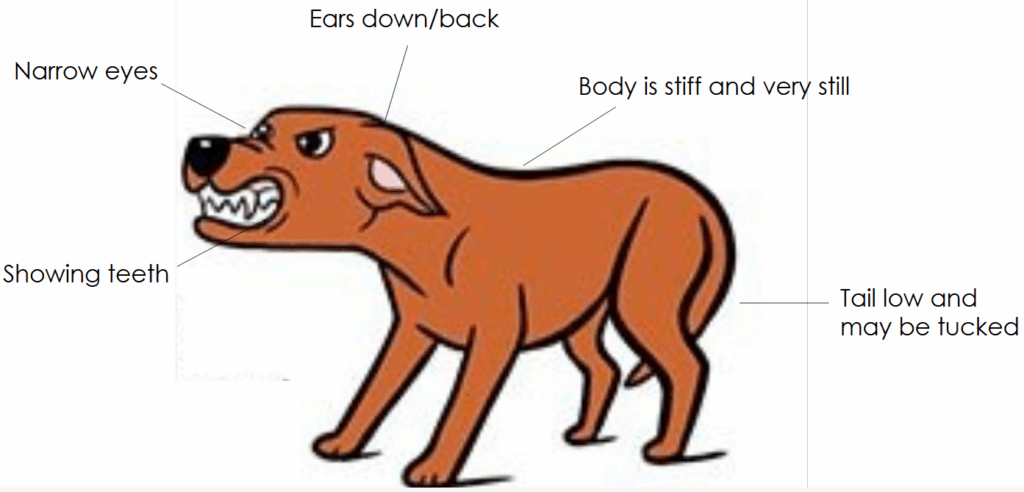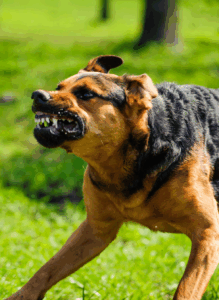A dog’s body language is their way of communicating with us and other dogs. It is important to look at all parts of a dog when attempting to assess how they are feeling. When dogs are fearful/anxious or aggressive/dominant, give them space! Any dog can bite. But body language isn’t a dog’s only way of communicating their emotions!
Keep reading to understand some of the key ways you can tell what your dog is feeling through their expression, body language, and actions!
Calm, Happy, and Playful dogs:

Calm/Happy/Playful Dogs will:
- Have their tail up, in line with the back (It may or may not be wagging)
- NOTE: If a tail is straight up in the air, this can mean a dog is acting dominant and can lead to aggression
- Ears pointed up and towards you
- Mouth open with their tongue hanging out (it looks like they’re smiling!)
- Body is in a relaxed position (standing with their heads held high, sitting, laying down/showing you their bellies)
- Eyes are open wide, and soft
- Playful dogs will have elbows on the ground and their hind ends up in the air
Calm, happy, or playful dogs typically show several clear body language signals. Their tails are usually up and in line with their backs, and while they may or may not be wagging, this position generally indicates a relaxed and confident state. However, it’s important to note that if a dog’s tail is held straight up in the air, it can be a sign of dominance and may lead to aggressive behavior. Their ears are often pointed up and directed toward you, showing alertness and interest. A happy dog’s mouth is usually open with their tongue hanging out, which can resemble a friendly smile. Their overall body posture is relaxed—whether they’re standing tall with heads held high, sitting calmly, lying down, or even rolling over to show their bellies. Their eyes are open wide but appear soft and gentle. Playful dogs may exhibit a special posture called a “play bow,” where their front elbows are on the ground and their hind end is raised in the air, inviting fun and interaction.


How to approach a happy dog:
- Ask for permission if you don’t know the dog well
- Okay to pet and play
- Let dogs come to you
- Always pet dogs in a nice way
When approaching a happy dog, it’s important to do so respectfully and safely. If you don’t know the dog well, always ask for permission from the owner before interacting. Once you have permission, it’s generally okay to pet and play with the dog. However, let the dog come to you first—this helps them feel more comfortable and in control of the interaction. When petting, always use gentle, kind motions to ensure the dog remains happy and relaxed.

Fearful, Anxious or Scared dogs

Fearful/Anxious/Scared dogs will:
- Whale eye (Can see the white part of a dogs eye, and their eyes will be wide open)
- Licking lips, panting and/or yawning
- Tails will be down low or tucked between their legs
- Crouched or shaking
- Ears held down or back
- Lips will be in a frowning position
Fearful, anxious, or scared dogs display several clear signs through their body language. One common sign is “whale eye,” where the white part of the eye is visible and the eyes are wide open, often indicating stress or discomfort. These dogs may also lick their lips, pant excessively, or yawn—behaviors that can signal anxiety. Their tails are typically held low or tucked tightly between their legs, and their bodies may appear crouched or even trembling. Ears are often pinned back or held down, and their mouths may form a frowning expression rather than the relaxed “smile” seen in happy dogs. These signals all point to a dog that is feeling fearful and should be approached with care and sensitivity.


How to act around a nervous dog:
- Do not approach
- Be a tree! (Stand still, arms at your side)
- Try to stay quiet and calm
- Stops dogs from becoming aggressive

When you’re around a nervous dog, it’s important to give them space and help them feel safe. Avoid approaching them, as this can increase their fear or anxiety. Instead, “be a tree” by standing still with your arms at your sides, allowing the dog to observe you without feeling threatened. Try to remain quiet and calm, as loud noises or sudden movements can make the dog more uneasy. By staying still and composed, you help prevent the dog from becoming defensive or aggressive, giving them a chance to settle down on their own.
Aggressive, Dominant and Angry dogs

Aggressive/Dominant/Angry Dogs will:
- Showing teeth, growling and/or barking
- Small, narrow eyes
- Ears low, and backwards
- Body language will be stiff and dogs will be very still) (But may lunge in an attempt to bite)
- Tail will be low and tucked
Aggressive, dominant, or angry dogs often display very distinct and tense body language. They may show their teeth, growl, or bark as clear warning signs. Their eyes tend to be small and narrow, giving them a focused or intense expression. The ears are usually held low and pinned backward, signaling discomfort or agitation. Their bodies will appear stiff and rigid, and while they may remain very still, they can suddenly lunge in an attempt to bite. Additionally, their tails are typically held low or tucked tightly under their bodies. These signs indicate that the dog is feeling threatened or is prepared to defend itself, so it’s important to remain cautious and avoid approaching.

How to act around an Angry Dog:
- Do not approach
- Be a tree! Be a rock
- Try to stay quiet and calm
- Stops dog from becoming aggressive
When you’re around an angry or aggressive dog, it’s crucial to avoid approaching them. Instead, stay still and calm—this is where the phrases “be a tree” or “be a rock” come in. Standing still like a tree or staying low and quiet like a rock helps you appear non-threatening. Avoid making eye contact or sudden movements, and try to remain as quiet and calm as possible. This behavior can prevent the dog from feeling more threatened and may stop the situation from escalating into aggression.

